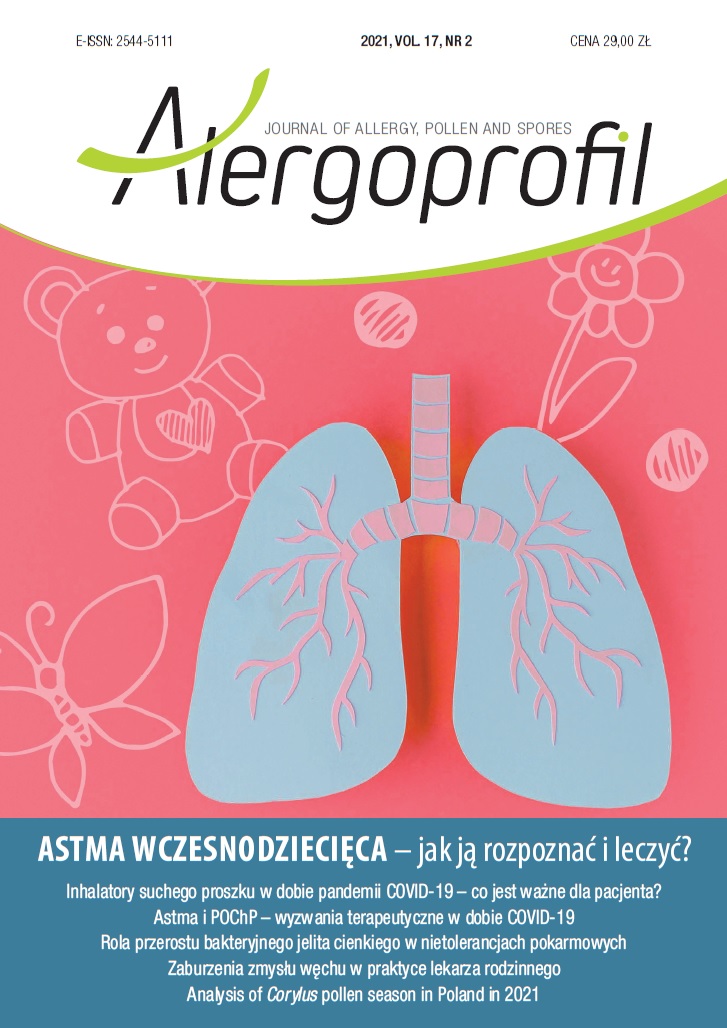A healthy nose of patient as an ally of the lung specialist Review article
Main Article Content
Abstract
The nose is the initial part of the upper airway. Its primary function is to mediate gas exchange, but it also protects the respiratory tract from the effects of varying external atmospheric conditions as well as physical and chemical substances contained in the inhaled air. Impaired nasal patency in the course of nasal diseases such as allergic rhinitis or rhinosinusitis adversely affects the function of the lower respiratory tract. Twenty years after the first ARIA (Allergic Rhinitis at its Impact to Asthma) document was published, the idea of a unified airway is still relevant today. Nasal function (or dysfunction) is of interest not only in patients with difficult to control symptoms of lower respiratory tract diseases.
Downloads
Article Details

This work is licensed under a Creative Commons Attribution-NonCommercial-NoDerivatives 4.0 International License.
Copyright: © Medical Education sp. z o.o. This is an Open Access article distributed under the terms of the Attribution-NonCommercial 4.0 International (CC BY-NC 4.0). License (https://creativecommons.org/licenses/by-nc/4.0/), allowing third parties to copy and redistribute the material in any medium or format and to remix, transform, and build upon the material, provided the original work is properly cited and states its license.
Address reprint requests to: Medical Education, Marcin Kuźma (marcin.kuzma@mededu.pl)
References
2. Pawliczak R. Nadreaktywność oskrzeli w praktyce klinicznej. Terapia. 2021; 4: 66-72.
3. Juusela M, Pallasaho P, Rönmark E et al. Dose-dependent association of smoking and bronchial hyperresponsiveness. Eur Respir J. 2013; 42(6): 1503-12.
4. Samoliński B, Krzych-Falta E, Piekarska B et al. 2019 ARIA – Care pathways for allergic rhinitis – Poland. Alergologia Polska – Polish Journal of Allergology. 2019; 6(4): 111-26. http://doi.org/10.5114/pja/2019.91214.
5. Ratner PH, Meltzer EO, Teper A. Mometasone furoate nasal spray is safe and effective for 1-year treatment of children with perennial allergic rhinitis. Int J Pediatr Otorhinolaryngol. 2009; 73(5): 651-7.
6. Arcimowicz M. Glikokortykosteroidy donosowe: fakty i mity. Alergoprofil. 2016; 12(3): 113-21.
7. Fokkens WJ, Lund VJ, Hopkins C et al. European Position Paper on Rhinosinusitis and Nasal Polyps, Rhinology. 2020; 58(suppl S29): 1-464. http://doi.org/10.4193/Rhin20.600 .
8. Samoliński B, Arcimowicz M (ed). PoSLeNN. Alergologia Polska – Polish Journal of Allergology. 2012; S1: 1-167.
9. Rot P, Rapiejko P, Jurkiewicz D. Intranasal steroid therapy – EPOS 2020. Otolaryngol Pol. 2020; 74(3): 41-9. http://doi.org/10.5604/01.3001.0014.2449.
10. Bosguet J, Cauwenberge PW, Khaltaev N et al. Allergic rhinitis and its impact on asthma. J Allergy Clin Immunol. 2001; 108(5 suppl): S147-334. http://doi.org/10.1067/mai.2001.118891.
11. Hryniewicz W, Albrecht P, Radzikowski A. Rekomendacje postępowania w pozaszpitalnych zakażeniach układu oddechowego. Narodowy Instytut Leków, Warszawa 2017.

